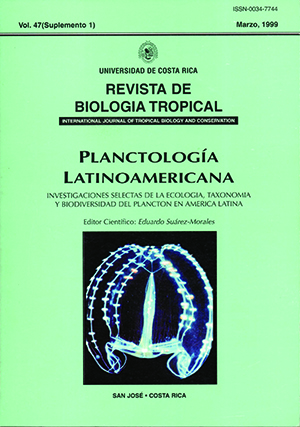Abstract
The reproductive characteristics of the populations of A. franciscana of Yavaros, Sonora; Bahía de Ceuta, Sinaloa, and San Francisco Bay, California U.S.A.were obtained in controlled conditions (salinity and temperature) and the following data were collected: length of male and female adults; width of abdomen and ovigerous sac; prereproductive, reproductive and postreproductive period; numher and frequency per broods. and number and percentage of the offspring produced per brood per female. San Francisco adults were larger and wider than those of Yavaros or Bahía de Ceuta. The total reproductive period was 43.6 days in Yavaros females and 29.7 days in Bahía de Ceuta. The number of broods was 5 for Yavaros and 3 for Ceuta as opposed to 14 for those of San Francisco. The period between broods was 4 days on average for the three populations. Thc average output of Yavaros was of 74 nauplii and 10 cysts/brood/female: for Bahía de Ceuta it was 22 nauplii and 5 cysts/brood/female. Output increased when both populations were eros sed with males from San Francísco Bay; the females of Yavaros had 400 nauplii per brood and the females of Bahía de Ceuta yielded 46 cysts per brood. These increases in production are attributed lo the greater intensily in courtship being in proportíon to the size of the males. San Francisco males, being larger, exhibít a greater intensity in courtship cven when females are smaller.References
Amat. F.D. 1984. Diferenciación y distribución de las poblaciones de Anemia (Crustáceo-Branquiópodo) de España. Intercanvi. Cientific 1 Extensio Universitaria. Universitat de Barcelona. 25 p.
Barata. C., F. Hontoria., F. Amat & R. Browne. 1996. Demographic parameters of sexual and parthenogenetic Artemia: temperature and strain effects. J. Exp. Mar. Biol. Ecol. 196: 329-340.
Bravo, G.C. 1997. Caracterización morfométrica y reproductiva de la población mexicana de Anemia sp. presente en la "Bahía de Ceuta". Sinaloa. México; e hibridación con Artemia franciscana. Tesis de Licenciatura. Universidad Autónoma Metropolitana-Xochimilco. CBS. Distrito Federal. México. 47 p.
Browne. R.A., L. E. Davis & S.E. Salle. 1988. Effects of temperature and relative fitness of sexual and asexual-brine shrimp Artemia. J. Exp. Mar. Biol. Ecol. 124: 1-20.
Browne, R.A, S. E. Salle, D. S. Grosch., W. O. Segreti & S. M. Purser. 1984. Partitioning genetic and environmental components of reproduction and lifespan in Artemia. Ecology 65: 949-960.
Castro, M. G., J. Castro, A. Malpica; R. De Lara & T. Castro. 1996. Aspectos del comportamiento biológico de Artemia franciscana de la población de Yavaros, Sonora, cultivada en diferentes salinidades. Oceanología 12:7-13.
Correa, S.F. & Bückle, R.L.F. 1993. Morfología y biometría de cinco poblaciones de Artemiafranciscuna (Anostraca: Artemiídae). Rev. Biol. Trop. 41: 103-110.
Gallardo, C. & J.Castro. 1987. Reproduction and genetics of mexicanArtemia. p. 249-253. In: P. Sorgeloos; D. Bengtson; W. Decleir y E. Jaspers. (Eds.) Artemia research and its applications. Vol. 1. Morphology, Genetics, Strain characterizatíon. Universa Press. Wetteren, Bélgica. 359 p.
Dana, G. L., R. Jellison, J.M. Melack & G. L. Starrett. 1993. Relationships between Artemia monica life history characteristics and salinity. Hydrobiologia
: 129-143.
Forbes, M.R.L., H.Pagola & R.L.Baker. 1992. Causes of a non-random pairing by size in the brine shrimp, Artenúa salina: (Crustacea:Anostraca). Oecología
:214-219.
Kuruppu. M.M. & S. U. K. Ekaratne. 1995. Effects of temperature and salinity on survival, growth and fecundity of the hrine shrimp Artemia arthenogenetica
from Sri Lanka. J. Natl. Sci. Conne.- Sri Lanca 23:161-169.
Lochhead, JA & M.S. Lochhead. 1940. The eggshells of the brine shrimp Artemia. Ana. Rec. 78 (4 Suppl.): 75-76
López, CJ. 1997. Caracterización morfométIica y reproductiva de la población mexicana de Anemia sp. presente en la salina 'Tres Hermanos", Yavaros, Sonora, México: e hibridación con Artemia Franciscana. Tesis de Licenciatura. Universidad Autónoma Metropolilana-Xochimilco. CBS. Distrito Federal. México.
p.
Malpica, S,A, J. Castro, G,L. Rodríguez, T. Castro, C. Gallardo & R. De Lara 1995, Características de la reproducción y del periodo de vida en las hembras de la población de Artemia spp, de la salina "Las Coloradas", Oaxaca, en condiciones de laboratorio, Oceanología 3: 127-133.
Nimura, Y, K. Nanba & M, I. Miab, 1994, Food utilization in Artemia [rom growth, reproduction, and maintenance. Fisheries Science (Tokyo) 60: 493-
Sorgeloos, P., Lavens, P. Léger, Ph., Tackaert, W. & Versichele, D. (1986). Manual for the culture and use of bline shrimp Artemia in aquaculture. State University of Ghent, Bélgica, 319 p.
Triantaphyllidis, G. V, K. Poulopoulou., T.J, Abatzopoulos., C.A. Pinto-Pérez & P. Sorgeloos. 1995, Salinity effects on survival, maturity, growth, biometrics, reproductive and lifespan characleristics of a bisexual and parthenogenetic population of Artermia. Hydrobiologia 302: 215-227,
Wang, R. & R. Zhang, 1995, Effect, of temperature and salinity on the biological character of Anemia strains, Acta Ecol. Sin, Shengtai Xuebao 15: 214-220.
##plugins.facebook.comentarios##

This work is licensed under a Creative Commons Attribution 4.0 International License.
Copyright (c) 1999 Revista de Biología Tropical


